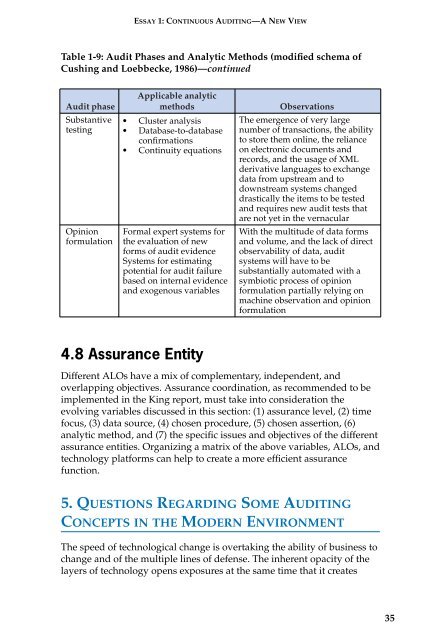AUDIT ANALYTICS AUDIT
1JWn3ix
1JWn3ix
Create successful ePaper yourself
Turn your PDF publications into a flip-book with our unique Google optimized e-Paper software.
ESSAY 1: CONTINUOUS <strong>AUDIT</strong>ING—A NEW VIEW<br />
Table 1-9: Audit Phases and Analytic Methods (modified schema of<br />
Cushing and Loebbecke, 1986)—continued<br />
Audit phase<br />
Substantive<br />
testing<br />
Opinion<br />
formulation<br />
Applicable analytic<br />
methods<br />
• Cluster analysis<br />
• Database-to-database<br />
confirmations<br />
• Continuity equations<br />
Formal expert systems for<br />
the evaluation of new<br />
forms of audit evidence<br />
Systems for estimating<br />
potential for audit failure<br />
based on internal evidence<br />
and exogenous variables<br />
Observations<br />
The emergence of very large<br />
number of transactions, the ability<br />
to store them online, the reliance<br />
on electronic documents and<br />
records, and the usage of XML<br />
derivative languages to exchange<br />
data from upstream and to<br />
downstream systems changed<br />
drastically the items to be tested<br />
and requires new audit tests that<br />
are not yet in the vernacular<br />
With the multitude of data forms<br />
and volume, and the lack of direct<br />
observability of data, audit<br />
systems will have to be<br />
substantially automated with a<br />
symbiotic process of opinion<br />
formulation partially relying on<br />
machine observation and opinion<br />
formulation<br />
4.8 Assurance Entity<br />
Different ALOs have a mix of complementary, independent, and<br />
overlapping objectives. Assurance coordination, as recommended to be<br />
implemented in the King report, must take into consideration the<br />
evolving variables discussed in this section: (1) assurance level, (2) time<br />
focus, (3) data source, (4) chosen procedure, (5) chosen assertion, (6)<br />
analytic method, and (7) the specific issues and objectives of the different<br />
assurance entities. Organizing a matrix of the above variables, ALOs, and<br />
technology platforms can help to create a more efficient assurance<br />
function.<br />
5. QUESTIONS REGARDING SOME <strong>AUDIT</strong>ING<br />
CONCEPTS IN THE MODERN ENVIRONMENT<br />
The speed of technological change is overtaking the ability of business to<br />
change and of the multiple lines of defense. The inherent opacity of the<br />
layers of technology opens exposures at the same time that it creates<br />
35


